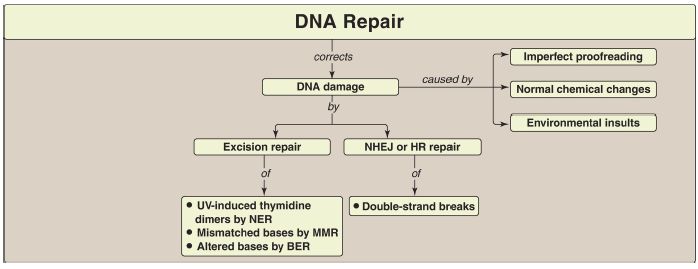


 النبات
النبات
 الحيوان
الحيوان
 الأحياء المجهرية
الأحياء المجهرية
 علم الأمراض
علم الأمراض
 التقانة الإحيائية
التقانة الإحيائية
 التقنية الحيوية المكروبية
التقنية الحيوية المكروبية
 التقنية الحياتية النانوية
التقنية الحياتية النانوية
 علم الأجنة
علم الأجنة
 الأحياء الجزيئي
الأحياء الجزيئي
 علم وظائف الأعضاء
علم وظائف الأعضاء
 الغدد
الغدد
 المضادات الحيوية
المضادات الحيوية|
Read More
Date: 25-9-2021
Date: 3-1-2022
Date: 2025-03-27
|
DNA
DNA is a polymer of deoxynucleoside monophosphates covalently linked by 3′→5′-phosphodiester bonds (Fig. 1). The resulting long, unbranched chain has polarity, with both a 5′-end (free phosphate) and a 3′- end (free hydroxyl). The sequence of nucleotides is read 5′→3′. DNA exists as a double-stranded molecule, in which the two chains are paired in an antiparallel manner and wind around each other, forming a double helix.
Adenine pairs with thymine, and cytosine pairs with guanine. Each strand of the double helix serves as a template for constructing a complementary daughter strand (semiconservative replication). DNA replication occurs in the S phase of the cell cycle and begins at an origin of replication. As the two strands unwind and separate, synthesis occurs at two replication forks that move away from the origin in opposite directions (bidirectionally).
Helicase unwinds the double helix. As the two strands of the double helix are separated, positive supercoils are produced in the region of DNA ahead of the replication fork and negative supercoils behind the fork. DNA topoisomerases types I and II remove supercoils. DNA polymerases (pols) synthesize new DNA strands only in the 5′→3′ direction. Therefore, one of the newly synthesized stretches of nucleotide chains must grow in the 5′→3′ direction toward the replication fork (leading strand) and one in the 5′→3′ direction away from the replication fork (lagging strand). DNA pols require a primer, a short stretch of RNA synthesized by primase. Leadingstrand synthesis needs only one RNA primer (continuous synthesis), whereas the lagging strand needs many (discontinuous synthesis involving Okazaki fragments). In Escherichia coli (E. coli), DNA chain elongation is catalyzed by DNA pol III, using 5′-deoxyribonucleoside triphosphates as substrates. The enzyme proofreads the newly synthesized DNA, removing terminal mismatched nucleotides with its 3′→5′ exonuclease activity.
RNA primers are removed by DNA pol I, using its 5′→3′ exonuclease activity. This enzyme fills the gaps with DNA, proofreading as it synthesizes. The final phosphodiester linkage is catalyzed by DNA ligase. There are at least five high-fidelity eukaryotic DNA pols. Pol α is a multisubunit enzyme, one subunit of which is a primase. Pol α 5′→3′ polymerase activity adds a short piece of DNA to the RNA primer. Pol ε completes DNA synthesis on the leading strand, whereas pol δ elongates each lagging strand fragment. Pol β is involved with DNA repair, and pol γ replicates mitochondrial DNA. Pols ε, δ, and γ use 3′→5′ exonuclease activity to proofread. Nucleoside analogs containing modified sugars can be used to block DNA chain growth. They are useful in anticancer and antiviral chemotherapy. Telomeres are stretches of highly repetitive DNA complexed with protein that protect the ends of linear chromosomes. As most cells divide and age, these sequences are shortened, contributing to senescence. In cells that do not senesce (for example, germline and cancer cells), the ribonucleoprotein telomerase employs its protein component reverse transcriptase to extend the telomeres, using its RNA component as a template. There are five classes of positively charged histone (H) proteins. Two of each of histones H2A, H2B, H3, and H4 form an octameric structural core around which DNA is wrapped, creating a nucleosome. The DNA connecting the nucleosomes, called linker DNA, is bound to H1. Nucleosomes can be packed more tightly to form a nucleofilament. Additional levels of organization create a chromosome.
Most DNA damage can be corrected by excision repair involving recognition and removal of the damage by repair proteins, followed by replacement by DNA pols and joining by ligase. Ultraviolet radiation can cause thymine dimers that are recognized and removed in E. coli by uvrABC proteins of nucleotide excision repair. Defects in the XP proteins needed for nucleotide excision repair of thymine dimers in humans result in xeroderma pigmentosum. Mismatched bases are repaired by a similar process of recognition and removal by Mut proteins in E. coli. The extent of methylation is used for strand identification in prokaryotes. Defective mismatch repair by homologous proteins in humans is associated with hereditary nonpolyposis colorectal cancer. Abnormal bases (such as uracil) are removed by DNA N-glycosylases in base excision repair, and the sugar phosphate at the apyrimidinic or apurinic site is cut out. Double-strand breaks in DNA are repaired by nonhomologous end joining (error prone) and template-requiring homologous recombination (“error-free”).


Figure 1: Key concept map for DNA structure, replication, and repair. Key concept map for DNA structure, replication, and repair. NHEJ = nonhomologous end joining; HR = homologous recombination; UV = ultraviolet; NER = nucleotide excision repair; MMR = mismatch repair; BER = base excision repair.



|
|
|
|
لشعر لامع وكثيف وصحي.. وصفة تكشف "سرا آسيويا" قديما
|
|
|
|
|
|
|
كيفية الحفاظ على فرامل السيارة لضمان الأمان المثالي
|
|
|
|
|
|
|
شعبة مدارس الكفيل: مخيَّم بنات العقيدة يعزِّز القيم الدينية وينمِّي مهارات اتخاذ القرار لدى المتطوِّعات
|
|
|